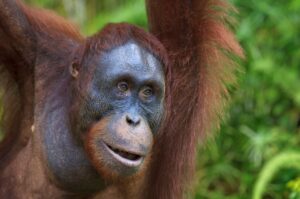A passion for the natural world drives many of our adventures. And when we’re not actually outside, we love delving into the discoveries about the places where we live and travel. Here are some of the best natural history links we’ve found this week.
Grandmother giraffes play key role in survival: Social organization in giraffes is much more advanced than previously thought, and akin to that of elephants. Turns out that grandmother giraffes then help raise future generations of offspring and ensure the preservation of their genes. The “Grandmother hypothesis” is seen in many mammals, including humans. Previously, ethologists believed that giraffes have almost no social structure.
Plastic creates evolutionary trap for young sea turtles: Plastic has turned up inside small juvenile turtles along both the east and west coasts of Australia. Young sea turtles spend their first few years in the open ocean, feeding near the surface. There are very few predators there and it gives them a much better chance of survival. But in a sad turn of events, huge amounts of plastic also accumulate here, and turtles will eat anything. “Hatchlings generally contained fragments up to about 5mm to 10mm in length, and particle size went up along with the size of the turtles,” said Dr. Emily Duncan.
Europe’s forgotten Atlantis
Doggerland: Lost ‘Atlantis’ of the North Sea: Doggerland is a vast expanse of land that was submerged because of a tsunami 8,000 years ago. The piece of land that fell to the bottom of the North Sea connected mainland Britain to modern-day Belgium, the Netherlands, and Scandinavia. After a decade of research and a myriad of archaeologists working at the site, a major exhibition is opening in Leiden, in the Netherlands, to give the public a window into Doggerland. “There was a period when Doggerland was dry and incredibly rich, a wonderful place for hunter-gatherers,” said Dr Van der Vaart-Verschoof.

A juvenile sea turtle. Photo: Shutterstock
Scientists expected thawing wetlands in Siberia’s permafrost. What they found is much more dangerous: The thawing wetlands of Siberia’s permafrost could lead to huge amounts of released methane. However, the heatwave in 2020 led to a surge in methane emissions from another unexpected source: rock formations in the arctic permafrost. While these might sound fairly similar, methane from rocks is much more dangerous. It releases hydrocarbons and gas hydrates that the methane from the wetlands does not.
Viruses on ice
15,000-year-old virus found in Tibetan glacier: Fifteen-thousand-year-old viruses have turned up in ice samples from the Tibetan Plateau. They have been able to survive because they were frozen for all those years. Of the 33 viruses found, 28 of them were previously unknown. Studying their genetic codes may help scientists understand how viruses have evolved over the centuries.
Sharks hide in Florida canal: Hundreds of sharks have been hiding in the canal near Longboat Key, Florida since July 16. Four species of shark have been spotted in the canal: bonnethead sharks, blacktip, lemon, and nurse sharks. Experts believe they are fleeing a red tide currently sweeping the Florida coast. The algal bloom releases a powerful neurotoxin and creates havoc in the marine ecosystem. “If it goes on long enough, they will run out of food and energy, and unfortunately, some of them — if not all of them — will die,” said Jack Morris, a senior biologist at Mote Marine Laboratory.

The Greenland Ice Sheet in the distance. Photo: Shutterstock
Greenland’s summer heatwave
Heat wave causes massive melt of Greenland ice sheet: Since July 28, the Greenland ice sheet has melted by roughly eight million tonnes a day -– double the average summer rate. This is because of a heatwave in Northern Greenland that has brought temperatures 10˚C above normal. The Greenland ice sheet is the second largest mass of freshwater ice on the planet, after the one in Antarctica. If it melted completely, it would raise ocean levels by six to seven meters. Luckily, the early summer was colder than usual, so the overall retreat for the ice sheet in 2021 remains within the historical norm.





